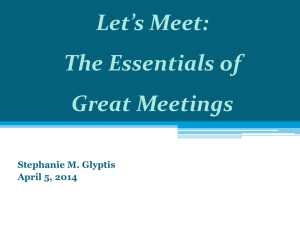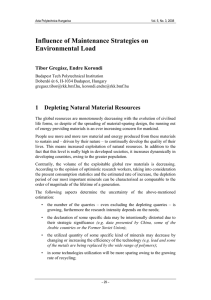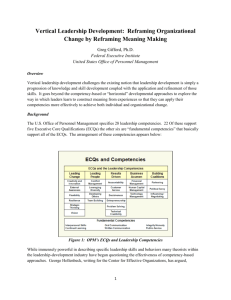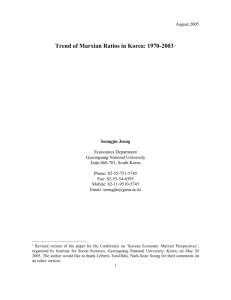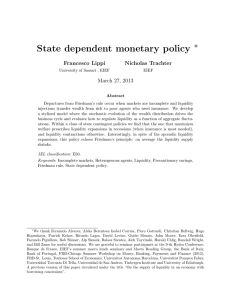Tools for Productive Conversation
advertisement
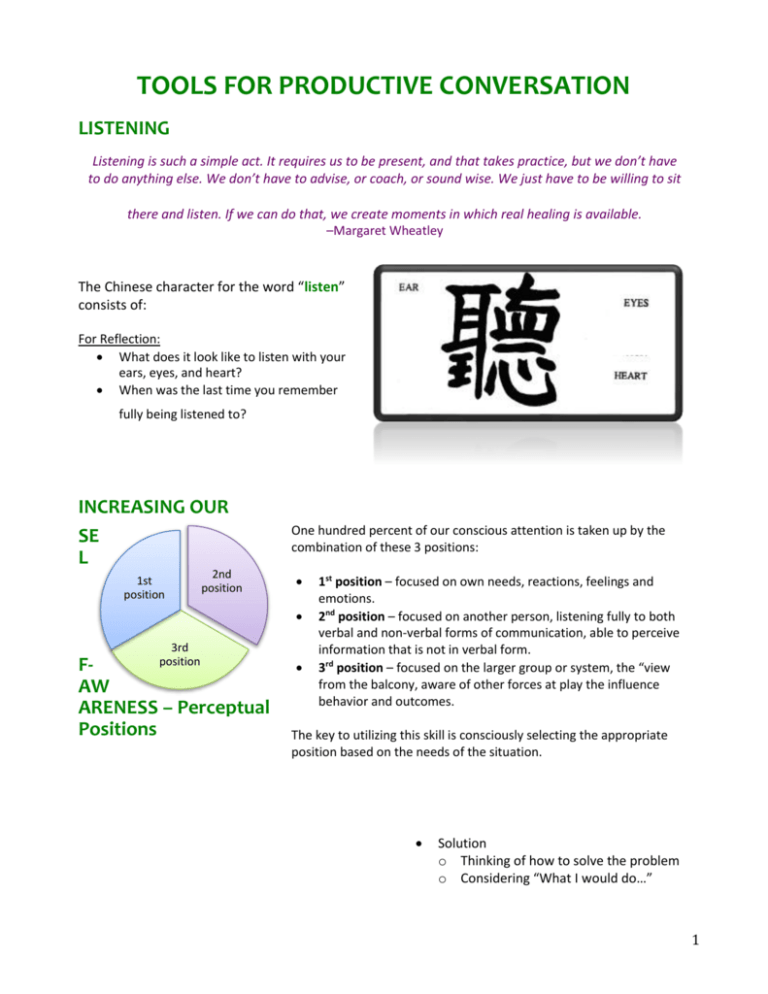
TOOLS FOR PRODUCTIVE CONVERSATION LISTENING Listening is such a simple act. It requires us to be present, and that takes practice, but we don’t have to do anything else. We don’t have to advise, or coach, or sound wise. We just have to be willing to sit there and listen. If we can do that, we create moments in which real healing is available. –Margaret Wheatley The Chinese character for the word “listen” consists of: For Reflection: What does it look like to listen with your ears, eyes, and heart? When was the last time you remember fully being listened to? INCREASING OUR SE L 1st position 2nd position One hundred percent of our conscious attention is taken up by the combination of these 3 positions: 3rd position FAW ARENESS – Perceptual Positions 1st position – focused on own needs, reactions, feelings and emotions. 2nd position – focused on another person, listening fully to both verbal and non-verbal forms of communication, able to perceive information that is not in verbal form. 3rd position – focused on the larger group or system, the “view from the balcony, aware of other forces at play the influence behavior and outcomes. The key to utilizing this skill is consciously selecting the appropriate position based on the needs of the situation. Listening Set-Asides Autobiographical o Thinking of personal relevance o Thinking of my own story Solution o Thinking of how to solve the problem o Considering “What I would do…” 1 HOW WE COMMUNICATE Many, and sometimes most, of the critical meaning generated in human encounters are elicited by touch, glance, vocal nuance, gesture, or facial expression with or without the aid of words. From the moment of recognition until the moment of separation, people observe each other with all their senses, hearing pauses and intonation, attending to dress and carriage, observing glance and facial tension, as well as noting word choice and syntax. Every harmony or disharmony of signals guides the interpretation of passing mood or enduring attribute. Out of the evaluations of kinetic, vocal, and verbal cues decisions are made to argue or agree, to laugh or blush, to relax or resist, to continue or to cut off conversation. D. Barnlund, Interpersonal Communication: Survey and Studies, pp. 256-257 Did You Know… 93% of a communicated message is non-verbal (38% tone of voice, 55% body language) Facial expression Gestures Tone of voice (pitch, volume, pacing) Body posture/position/proximity 7% of a communicated message is verbal Words Thomas Crane, The Heart of Coaching For Reflection: What does this mean about how I listen? What does it mean about how I communicate? Putting It Into Practice Inquiry Stance Advocacy Stance “I want to better understand you.” “I want you to better understand me.” Seeks to understand what others mean Seeks to make oneself understood What do you mean by…? I say this because… Can you help me understand…? I’m seeing this from the viewpoint of… Say more… Let me share my thinking on this… 2 PRODUCTIVE DISCOURSE Shifting the Discourse | From Blame & Complaint to Care & Commitment Sometimes we get stuck in conversations – we hold back because we don’t know how to express ourselves in a productive way or we don’t know how to respond productively to others’ negative and judgmental expressions. In their book How the Way We Talk Can Change the Way We Work, authors Robert Kegan and Lisa Lahey share ways to shift from unproductive to productive discourse. To start, they tackle the language of blame and complaint. Rather than joining in with the negative talk or being triggered or silenced by it, they suggest there is potential in every negative statement: Hidden River of Care We would not complain about anything if we did not care about something. Beneath the surface torrent of complaining lies a hidden river of our caring, that which we most prize or to which we are most committed. So one skill that can be practiced is identifying the “care” and “commitment” behind the statements of blame and complaints (nagging, bitching, moaning, etc.) we hear or express. This interrupts unproductive discourse so the possibility of moving the conversation in a productive direction becomes available. Putting It Into Practice Blame & Complaint Care & Commitment Tells people what you can’t stand Tells others what you deeply care about Tells others what they should/n’t do Takes responsibility for what you care about I can’t stand it when she does that What I care about is clear communication He shouldn’t do it that way I can see where I need to improve my own reactions to people We believe the language of complaint can be revisited for the purpose of being redeemed – that it contains a transformative element or seed. Where there is passion, there are also possibilities for transformation. -- Kegan & Lahey 3 NONDISCUSSABLES Nondiscussables are subjects sufficiently important that they are talked about frequently but are so laden with anxiety and fearfulness that these conversations take place only in the parking lot, the rest rooms, the playground, the car pool, or the dinner table at home. Fear abounds that open discussion of these incendiary issues –– at a faculty meeting, for example, will cause a meltdown. The nondiscussable is the elephant in the living room. Everyone knows that this huge pachyderm is there, right between the sofa and the fireplace, but we go on mopping and dusting and vacuuming around as if it did not exist. Why Do We Avoid Hard Conversations? The brain has been observed to “shut down” when negative psychological feedback such as threat, criticism, and failure result in the defensive measure of downshifting. John Abbott Downshifting is the tendency under stress to shift to a defensive mode and become less flexible and open to new information and ideas. Downshifting is the psycho-physiological response to threat, accompanied by a sense of helplessness, fatigue, fear, or anxiety. The brain learns optimally when appropriately challenged, but downshifts under perceived threat. A secure, nonthreatening environment counteracts downshifting. Renate Caine & Geoffrey Caine USING OUR TOOLS Listen fully Set aside unproductive patterns of listening Choose to understand someone else’s perspective before expecting others to understand you Find the hidden river of caring in negative statements 4





